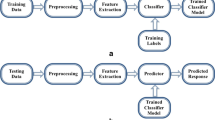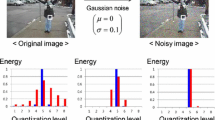Abstract
In this article, we present a framework to detect pedestrians in presence of various real world challenges. The depth-level occlusion is addressed by a stereo-aided triangulation mechanism, where the ORB (Oriented FAST and Rotated BRIEF) descriptor is used to speed up the disparity estimation. An empirical formulation has been made to compute the maximum feasible window size during region proposals generation. The variation of unusual articulated postures is tackled with a shape-histogram representation that uses a set of oriented, high-frequency kernels to compute the gradient details; a set of co-occurrence texture cues is further taken into consideration to strengthen the resulting descriptor. We validate the efficacy of our method on three benchmark pedestrian datasets, where the obtained results are expressed in terms of five performance metric.











Similar content being viewed by others
References
Arthur D, Vassilvitskii S (2007) K-means++: The advantages of careful seeding. In: Proceedings of the 18th annual ACM-SIAM symposium on discrete algorithms. Society for Industrial and Applied Mathematics, pp 1027–1035
Benenson R, Omran M, Hosang J, Schiele B (2014) Ten years of pedestrian detection, what have we learned?. In: European conference on computer vision. Springer, pp 613–627. https://doi.org/10.1007/978-3-319-16181-5_47
Brown LM, Feris R, Pankanti S (2014) Temporal non-maximum suppression for pedestrian detection using self-calibration. In: International conference on pattern recognition. IEEE, pp 2239–2244. https://doi.org/10.1109/ICPR.2014.389
Brunetti A, Buongiorno D, Trotta GF, Bevilacqua V (2018) Computer vision and deep learning techniques for pedestrian detection and tracking: a survey. Neurocomputing 300:17–33. https://doi.org/10.1016/j.neucom.2018.01.092
Comaniciu D, Ramesh V, Meer P (2003) Kernel-based object tracking. IEEE Trans Pattern Anal Mach Intell 25(5):564–577. https://doi.org/10.1109/TPAMI.2003.1195991
Cutler R, Davis LS (2000) Robust real-time periodic motion detection, analysis, and applications. IEEE Trans Pattern Anal Mach Intell 22(8):781–796. https://doi.org/10.1109/34.868681
Dalal N, Triggs B (2005) Histograms of oriented gradients for human detection. In: IEEE conference on computer vision and pattern recognition, vol 1. IEEE, pp 886–893. https://doi.org/10.1109/CVPR.2005.177
Dalal N, Triggs B, Schmid C (2006) Human detection using oriented histograms of flow and appearance. In: European conference on computer vision. Springer, pp 428–441. https://doi.org/10.1007/11744047_33
Dollar P, Wojek C, Schiele B, Perona P (2012) Pedestrian detection: an evaluation of the state of the art. IEEE Trans Pattern Anal Mach Intell 34(4):743–761. https://doi.org/10.1109/TPAMI.2011.155
Enzweiler M, Gavrila DM (2009) Monocular pedestrian detection: survey and experiments. IEEE Trans Pattern Anal Mach Intell 31(12):2179–2195. https://doi.org/10.1109/TPAMI.2008.260
Errami M, Rziza M (2016) Improving pedestrian detection using support vector regression. In: 13th international conference on computer graphics, imaging and visualization. IEEE, pp 156–160. https://doi.org/10.1109/CGiV.2016.38
Ess A, Leibe B, Schindler K, van Gool L (2008) A mobile vision system for robust multi-person tracking. In: IEEE conference on computer vision and pattern recognition. IEEE. https://doi.org/10.1109/CVPR.2008.4587581
Everingham M, Van Gool L, Williams CK, Winn J, Zisserman A (2010) The pascal visual object classes (VOC) challenge. Int J Comput Vis 88(2):303–338. https://doi.org/10.1007/s11263-009-0275-4
Gavrila DM (2007) A Bayesian, exemplar-based approach to hierarchical shape matching. IEEE Trans Pattern Anal Mach Intell 29(8):1408–1421. https://doi.org/10.1109/TPAMI.2007.1062
Gerónimo D, Sappa A, López A, Ponsa D (2007) Adaptive image sampling and windows classification for on-board pedestrian detection. In: International conference on computer vision systems, vol 39
Geronimo D, Lopez AM, Sappa AD, Graf T (2010) Survey of pedestrian detection for advanced driver assistance systems. IEEE Trans Pattern Anal Mach Intell 32(7):1239–1258. https://doi.org/10.1109/TPAMI.2009.122
Gurbuz SZ, Melvin WL, Williams DB (2012) Kinematic model-based human detectors for multi-channel radar. IEEE Trans Aerosp Electron Syst 48(2):1306–1318. https://doi.org/10.1109/TAES.2012.6178063
Haralick RM, Shanmugam K, Dinstein I (1973) Textural features for image classification. IEEE Trans Syst Man Cybern SMC-3(6):610–621. https://doi.org/10.1109/TSMC.1973.4309314
Hirschmuller H (2008) Stereo processing by semiglobal matching and mutual information. IEEE Trans Pattern Anal Mach Intell 30(2):328–341. https://doi.org/10.1109/TPAMI.2007.1166
Li J, Liang X, Shen S, Xu T, Feng J, Yan S (2018) Scale-aware fast r-cnn for pedestrian detection. IEEE Trans Multimed 20(4):985–996. https://doi.org/10.1109/TMM.2017.2759508
Liang F, Wang D, Liu Y, Jiang Y, Tang S (2012) Fast pedestrian detection based on sliding window filtering. In: Pacific-rim conference on multimedia. Springer, pp 811–822. https://doi.org/10.1007/978-3-642-34778-8_76
Lin Z, Davis LS (2008) A pose-invariant descriptor for human detection and segmentation. In: European conference on computer vision, pp 423–436. Springer. https://doi.org/10.1007/978-3-540-88693-8_31
Lin Z, Davis LS (2010) Shape-based human detection and segmentation via hierarchical part-template matching. IEEE Trans Pattern Anal Machine Intell 32 (4):604–618. https://doi.org/10.1109/TPAMI.2009.204
Liu Y, Lasang P, Siegel M, Sun Q (2016) Multi-sparse descriptor: a scale invariant feature for pedestrian detection. Neurocomputing 184:55–65. https://doi.org/10.1016/j.neucom.2015.07.143
Lv Q, Josephson W, Wang Z, Charikar M, Li K (2007) Multi-probe LSH: efficient indexing for high-dimensional similarity search. In: Proceedings of the 33rd international conference on very large data bases. VLDB Endowment, pp 950–961
Maji S, Berg AC, Malik J (2008) Classification using intersection kernel support vector machines is efficient. In: IEEE conference on computer vision and pattern recognition. IEEE, pp 1–8. https://doi.org/10.1109/CVPR.2008.4587630
Mohan A, Papageorgiou C, Poggio T (2001) Example-based object detection in images by components. IEEE Trans Pattern Anal Mach Intell 23(4):349–361. https://doi.org/10.1109/34.917571
Mu Y, Yan S, Liu Y, Huang T, Zhou B (2008) Discriminative local binary patterns for human detection in personal album. In: IEEE conference on computer vision and pattern recognition. IEEE, pp 1–8. https://doi.org/10.1109/CVPR.2008.4587800
Nguyen DT, Li W, Ogunbona PO (2016) Human detection from images and videos: a survey. Pattern Recogn 51:148–175. https://doi.org/10.1016/j.patcog.2015.08.027
Ouyang W, Wang X (2012) A discriminative deep model for pedestrian detection with occlusion handling. In: 2012 IEEE conference on computer vision and pattern recognition. IEEE, pp 3258–3265. https://doi.org/10.1109/CVPR.2012.6248062
Ouyang W, Zeng X, Wang X (2013) Modeling mutual visibility relationship in pedestrian detection. In: Proceedings of the IEEE conference on computer vision and pattern recognition. IEEE, pp 3222–3229. https://doi.org/10.1109/CVPR.2013.414
Ouyang W, Zhou H, Li H, Li Q, Yan J, Wang X (2018) Jointly learning deep features, deformable parts, occlusion and classification for pedestrian detection. IEEE Trans Pattern Anal Mach Intell 40(8):1874–1887. https://doi.org/10.1109/TPAMI.2017.2738645
Rittscher J, Tu PH, Krahnstoever N (2005) Simultaneous estimation of segmentation and shape. In: IEEE conference on computer vision and pattern recognition, vol 2. IEEE, pp 486–493. https://doi.org/10.1109/CVPR.2005.323
Rublee E, Rabaud V, Konolige K, Bradski G (2011) ORB: An efficient alternative to SIFT or SURF. In: 2011 international conference on computer vision. IEEE, pp 2564–2571. https://doi.org/10.1109/ICCV.2011.6126544
Schwartz WR, Kembhavi A, Harwood D, Davis LS (2009) Human detection using partial least squares analysis. In: 12th international conference on computer vision. IEEE, pp 24–31. https://doi.org/10.1109/ICCV.2009.5459205
Shen J, Zuo X, Yang W, Prokhorov D, Mei X, Ling H (2018) Differential features for pedestrian detection: A taylor series perspective. IEEE Trans Intell Transp Syst. https://doi.org/10.1109/TITS.2018.2869087
Walk S, Majer N, Schindler K, Schiele B (2010) New features and insights for pedestrian detection. In: IEEE conference on computer vision and pattern recognition. IEEE, pp 1030–1037. https://doi.org/10.1109/CVPR.2010.5540102
Wang X, Han TX, Yan S (2009) An HOG-LBP human detector with partial occlusion handling. In: 12th international conference on computer vision. IEEE, pp 32–39. https://doi.org/10.1109/ICCV.2009.5459207
Wei Y, Tian Q, Guo T (2013) An improved pedestrian detection algorithm integrating Haar-like features and HOG descriptors. Adv Mech Eng 5(546):206. https://doi.org/10.1155/2013/546206
Wu B, Nevatia R (2005) Detection of multiple, partially occluded humans in a single image by Bayesian combination of edgelet part detectors. In: IEEE international conference on computer vision, vol 1. IEEE, pp 90–97. https://doi.org/10.1109/ICCV.2005.74
Yao S, Pan S, Wang T, Zheng C, Shen W, Chong Y (2015) A new pedestrian detection method based on combined HOG and LSS features. Neurocomputing 151:1006–1014. https://doi.org/10.1016/j.neucom.2014.08.080
Zhang S, Benenson R, Schiele B (2015) Filtered channel features for pedestrian detection. In: IEEE conference on computer vision and pattern recognition. IEEE, pp 1751–1760. https://doi.org/10.1109/CVPR.2015.7298784
Zhang X, Hu HM, Jiang F, Li B (2015) Pedestrian detection based on hierarchical co-occurrence model for occlusion handling. Neurocomputing 168:861–870. https://doi.org/10.1016/j.neucom.2015.05.038
Zhang S, Benenson R, Omran M, Hosang J, Schiele B (2018) Towards reaching human performance in pedestrian detection. IEEE Trans Pattern Anal Mach Intell 40(4):973–986. https://doi.org/10.1109/TPAMI.2017.2700460
Zhao T, Nevatia R, Wu B (2008) Segmentation and tracking of multiple humans in crowded environments. IEEE Trans Pattern Anal Mach Intell 30(7):1198–1211. https://doi.org/10.1109/TPAMI.2007.70770
Zhu Q, Yeh MC, Cheng KT, Avidan S (2006) Fast human detection using a cascade of histograms of oriented gradients. In: IEEE conference on computer vision and pattern recognition, vol 2. IEEE, pp 1491–1498. https://doi.org/10.1109/CVPR.2006.119
Author information
Authors and Affiliations
Corresponding author
Additional information
Publisher’s Note
Springer Nature remains neutral with regard to jurisdictional claims in published maps and institutional affiliations.
Rights and permissions
About this article
Cite this article
Choudhury, S.K., Padhy, R.P., Sa, P.K. et al. Human detection using orientation shape histogram and coocurrence textures. Multimed Tools Appl 78, 13949–13969 (2019). https://doi.org/10.1007/s11042-018-6866-8
Received:
Revised:
Accepted:
Published:
Issue Date:
DOI: https://doi.org/10.1007/s11042-018-6866-8




